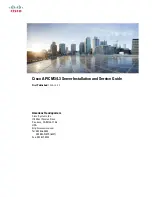
Select this choice to view configuration information, including the ID, speed, and cache size of the
microprocessors, machine type and model of the server, QPI link speed, the serial number, the system
UUID, and the amount of installed memory. When you make configuration changes through other
choices in the Setup utility, the changes are reflected in the system summary; you cannot change
settings directly in the system summary.
–
Product Data
Select this choice to view, the revision level or issue date of the firmware, the integrated management
module and diagnostics code, and the version and date.
•
System Settings
Select this choice to view or change the server component settings. This choice is on the full Setup utility
menu only.
–
Adapters and UEFI Drivers
Select this choice if you want to use the configuration capabilities of older generation UEFI device
drivers to configure the device.
–
Devices and I/O Ports
Select this choice to view or change settings for devices and input/output (I/O) ports. You can configure
the serial ports; configure remote console redirection; enable or disable the Ethernet controller, SAS/
SATA controller, SATA optical drive channels, and PCI slots. If you disable a device, it cannot be
configured, and the operating system will not be able to detect it (this is equivalent to disconnecting the
device).
–
Driver Health
Select this choice to view the health of the controllers in the server as reported by their device drivers.
–
Integrated Management Module
Select this choice to view or change the settings for the integrated management module.
–
Power Restore Policy
Select this choice to determine the mode of operation to which the server will be restored after a
power outage occurs. You can select
Always Off
,
Restore
, or
Always On
to restore the server the
state that it was set to at the time of the power outage.
–
Commands on USB Interface Preference
Select this choice to enable or disable the Ethernet over USB interface on the IMM.
–
Network Configuration
Select this choice to view the systems-management network interface port, the IMM MAC address,
the current IMM IP address, the system Ethernet MAC addresses, and the host name; define the
static IMM IP address, subnet mask, and gateway address; specify whether to use the static IP
address or have DHCP assign the IMM IP address; save the network changes; and reset the IMM.
–
Reset IMM to Defaults
Select this choice to reset the IMM to the default settings.
–
Reset IMM
Select this choice to reset the IMM settings.
–
Legacy Support
Select this choice to view or set legacy support.
–
Force Legacy Video on Boot
Select this choice to force legacy video support, if the operating system does not support UEFI
video output standards.
–
Rehook INT 19H
124
System x3850 X6 and x3950 X6 Installation and Service Guide
Summary of Contents for 6241
Page 1: ...System x3850 X6 and x3950 X6 Installation and Service Guide Machine Type 6241 ...
Page 6: ...iv System x3850 X6 and x3950 X6 Installation and Service Guide ...
Page 56: ...42 System x3850 X6 and x3950 X6 Installation and Service Guide ...
Page 82: ...68 System x3850 X6 and x3950 X6 Installation and Service Guide ...
Page 132: ...118 System x3850 X6 and x3950 X6 Installation and Service Guide ...
Page 158: ...144 System x3850 X6 and x3950 X6 Installation and Service Guide ...
Page 214: ...200 System x3850 X6 and x3950 X6 Installation and Service Guide ...
Page 358: ...344 System x3850 X6 and x3950 X6 Installation and Service Guide ...
Page 1938: ...1924 System x3850 X6 and x3950 X6 Installation and Service Guide ...
Page 1964: ...1950 System x3850 X6 and x3950 X6 Installation and Service Guide ...
Page 1968: ...1954 System x3850 X6 and x3950 X6 Installation and Service Guide ...
Page 1975: ...Taiwan Class A compliance statement Appendix F Notices 1961 ...
Page 1976: ...Taiwan BSMI RoHS declaration 1962 System x3850 X6 and x3950 X6 Installation and Service Guide ...
Page 1988: ...1974 System x3850 X6 and x3950 X6 Installation and Service Guide ...
Page 1989: ......
Page 1990: ......
















































